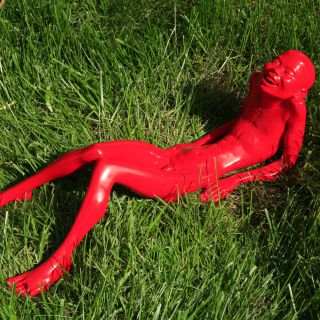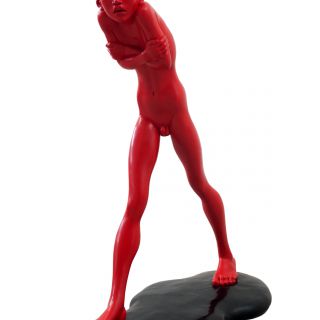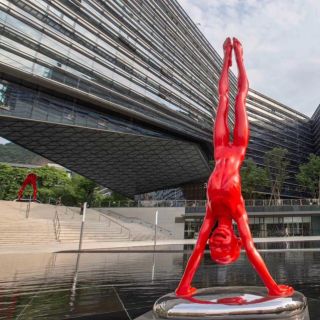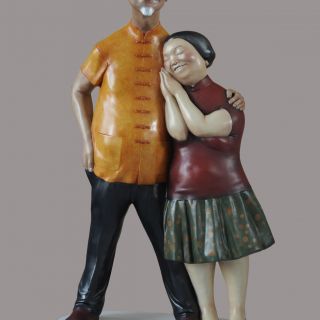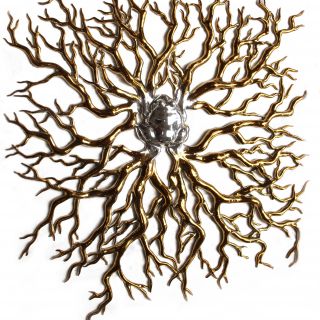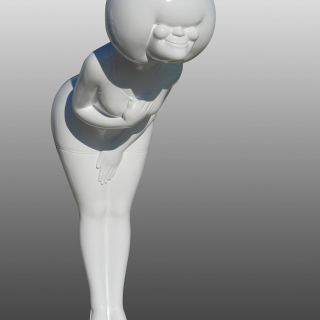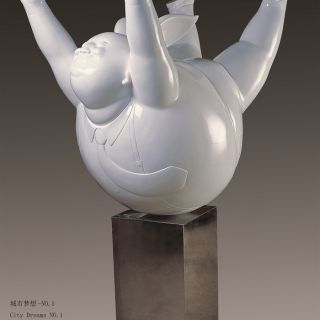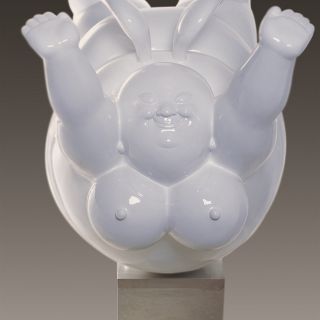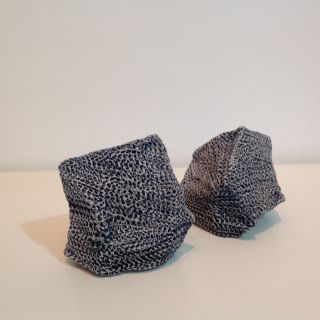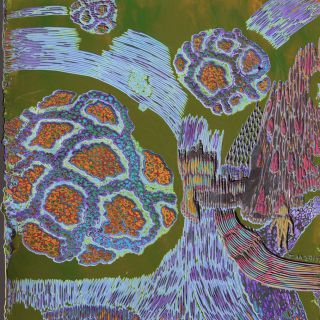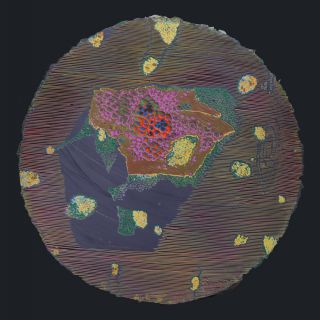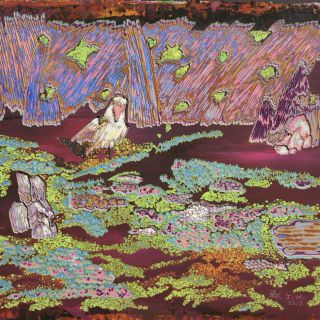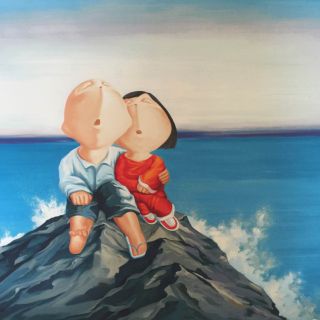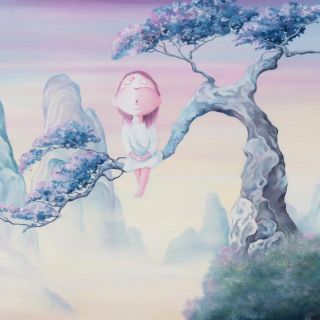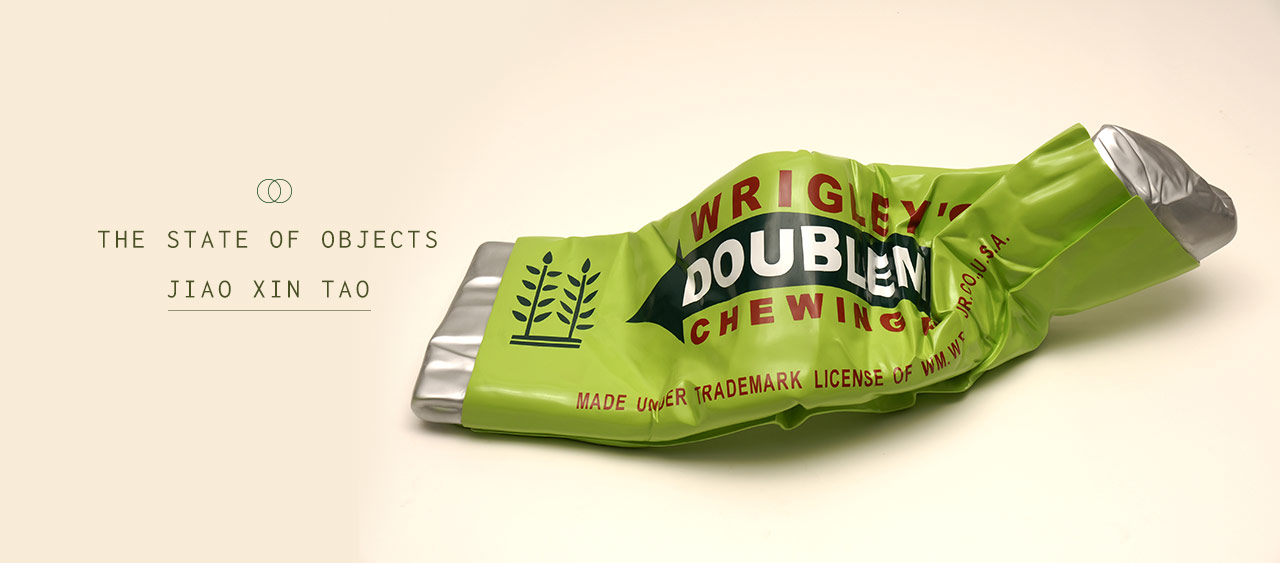
Jiao Xin Tao was born in Chengdu, China in 1970 and graduated from the Sichuan Academy of Fine Arts, Chongqing with a Masters in Fine Arts in 1996.
His works are famous for revolving around the theme of consumerism, often featuring negligible objects such as discarded packaging and other castaway objects. Jiao takes familiar everyday items—empty milk cartons, discarded wrappers, plastic bags—and transforms them into fibreglass artistic objects. Playing with scale and a hyper-realistic attention to detail, the artist recreates these objects on grand proportions. His monumental sculptures of common products render the objects with meticulous detail, so as to reveal the true aesthetic value behind these seemingly insignificant remnants of daily life. Pushing artistic and aesthetic boundaries, the artist establishes a running commentary on the overly materialistic and consumerist attitude of contemporary society, creating sculpture which evokes a philosophical response in addition to visual appreciation.
His works are famous for revolving around the theme of consumerism, often featuring negligible objects such as discarded packaging and other castaway objects. Jiao takes familiar everyday items—empty milk cartons, discarded wrappers, plastic bags—and transforms them into fibreglass artistic objects. Playing with scale and a hyper-realistic attention to detail, the artist recreates these objects on grand proportions. His monumental sculptures of common products render the objects with meticulous detail, so as to reveal the true aesthetic value behind these seemingly insignificant remnants of daily life. Pushing artistic and aesthetic boundaries, the artist establishes a running commentary on the overly materialistic and consumerist attitude of contemporary society, creating sculpture which evokes a philosophical response in addition to visual appreciation.
Viewing 2 works by Jiao Xin Tao
Sort
Biography 
Biography
Jiao Xin Tao was born in Chengdu, China in 1970 and graduated from the Sichuan Academy of Fine Arts, Chongqing with a Masters in Fine Arts in 1996.
His works are famous for revolving around the theme of consumerism, often featuring negligible objects such as discarded packaging and other castaway objects. Jiao takes familiar everyday items — empty milk cartons, discarded wrappers, plastic bags — and transforms them into fibreglass artistic objects. Playing with scale and a hyper-realistic attention to detail, the artist recreates these objects on grand proportions. His monumental sculptures of common products renders the object with such meticulous detail as to reveal the true aesthetic value behind these seemingly insignificant remnants of daily life. Pushing artistic and aesthetic boundaries, the artist establishes a running commentary on the overly materialistic and consumerist attitude of contemporary society, creating sculpture which evokes a philosophical response in addition to visual appreciation.
Besides having held and participated in several solo and group exhibitions in several regions throughout China, his sculptures have been exhibited internationally in countries such as Germany, Italy and the Netherlands. The reason for Jiao Xing Tao's fame in the sculpture industry probably relates to his deconstructive style of works of the 1990s. After that period, his creations mostly focused on the breakthrough of traditional sculpture language,and promotes the expressions of the new figurative sculptures, at the same time they break through the boundary between sculpture and installation works. He also tries to discover the expressions of concepts in the field of sculpture, and the exhibition today is a presentation of his experiments.
The word "Common" (Chinese: 常 Cháng) has double meanings: one is "common", the other is "uncommon". While "common" means the focus of daily routines, everyday living, micro matters, and the pursuit of studies on inner self, it also focuses on the relationships between real life and the sculpture itself. "Uncommon" focuses on visual expression, in other words, it's the pursuit of de-familiarization. Here, the influence of de-familiarization originates from a rebellion of the artist's daily visual experiences, and the "recode" of those works, which creates a strong visual contrast when you look at it.
"Hidden" (Chinese: 藏 Cáng) is the reaction for the word "code". However, it can also be seen as a concept. For example, the artist intentionally "hides" things, and binds his sculptures with common objects, thus incorporating these works into daily experiences. The reason why we can see the characteristics of concepts is because the artist was eliminating the boundary between a work of art and a common object. After Duchamp, the boundary between daily objects and artwork became blurred, however, Duchamp did not mix the artwork into the daily lives of people.
The "environment" (Chinese: 场 Chǎng) is also descended from "hidden", however, it can only be expressed in the effect of the works when they are shown. There are two concepts of the word "environment". One is a place to display objects and ideas "live" and in real time, the other is to create a theatrical presence. The "live" environment was created by the use of daily objects and backgrounds. However, the presence of the environment is not pure expression but merely the surface of the work as art pieces are "hidden" inside. Therefore, artwork becames a middle object and makes the audience's common visual experiences become a behaviour of art. While the theatrical presence creates a new visual relationship, the other effect is that it makes the audience's visual experiences bind with the work, the environment and become part of the work.
Selected Awards and Accolades
2001 - Beijing International Urban Sculpture Invitation Exhibition
Bronze Medal, 9th Annual National Art Exhibition, Beijing, China
1999 - SpecialtyPrize, Chonqing Inaugural Art and Literature Awards, Chongqing, China,
His works are famous for revolving around the theme of consumerism, often featuring negligible objects such as discarded packaging and other castaway objects. Jiao takes familiar everyday items — empty milk cartons, discarded wrappers, plastic bags — and transforms them into fibreglass artistic objects. Playing with scale and a hyper-realistic attention to detail, the artist recreates these objects on grand proportions. His monumental sculptures of common products renders the object with such meticulous detail as to reveal the true aesthetic value behind these seemingly insignificant remnants of daily life. Pushing artistic and aesthetic boundaries, the artist establishes a running commentary on the overly materialistic and consumerist attitude of contemporary society, creating sculpture which evokes a philosophical response in addition to visual appreciation.
Besides having held and participated in several solo and group exhibitions in several regions throughout China, his sculptures have been exhibited internationally in countries such as Germany, Italy and the Netherlands. The reason for Jiao Xing Tao's fame in the sculpture industry probably relates to his deconstructive style of works of the 1990s. After that period, his creations mostly focused on the breakthrough of traditional sculpture language,and promotes the expressions of the new figurative sculptures, at the same time they break through the boundary between sculpture and installation works. He also tries to discover the expressions of concepts in the field of sculpture, and the exhibition today is a presentation of his experiments.
The word "Common" (Chinese: 常 Cháng) has double meanings: one is "common", the other is "uncommon". While "common" means the focus of daily routines, everyday living, micro matters, and the pursuit of studies on inner self, it also focuses on the relationships between real life and the sculpture itself. "Uncommon" focuses on visual expression, in other words, it's the pursuit of de-familiarization. Here, the influence of de-familiarization originates from a rebellion of the artist's daily visual experiences, and the "recode" of those works, which creates a strong visual contrast when you look at it.
"Hidden" (Chinese: 藏 Cáng) is the reaction for the word "code". However, it can also be seen as a concept. For example, the artist intentionally "hides" things, and binds his sculptures with common objects, thus incorporating these works into daily experiences. The reason why we can see the characteristics of concepts is because the artist was eliminating the boundary between a work of art and a common object. After Duchamp, the boundary between daily objects and artwork became blurred, however, Duchamp did not mix the artwork into the daily lives of people.
The "environment" (Chinese: 场 Chǎng) is also descended from "hidden", however, it can only be expressed in the effect of the works when they are shown. There are two concepts of the word "environment". One is a place to display objects and ideas "live" and in real time, the other is to create a theatrical presence. The "live" environment was created by the use of daily objects and backgrounds. However, the presence of the environment is not pure expression but merely the surface of the work as art pieces are "hidden" inside. Therefore, artwork becames a middle object and makes the audience's common visual experiences become a behaviour of art. While the theatrical presence creates a new visual relationship, the other effect is that it makes the audience's visual experiences bind with the work, the environment and become part of the work.
Selected Awards and Accolades
2001 - Beijing International Urban Sculpture Invitation Exhibition
Bronze Medal, 9th Annual National Art Exhibition, Beijing, China
1999 - SpecialtyPrize, Chonqing Inaugural Art and Literature Awards, Chongqing, China,
Exhibitions 
Exhibitions
2010
"Be", Solo Exhibition, Chongqing Organhaus Art Space
Nature of China :Contemporary Art Documentary
Suzhou True Color Museum "Reshaping History" Chinart from 2000 To 2009, Beijing China
National Convention Center, China
2009
First Chongqing Young Artists Biennale
Chongqing Convention Center "Diagonal" Contemporary Academic Sculpture Exhibition
Luxun Academy of Fine Arts Museum of Art
2008
International Exhibition of Sculptures and Installations Venice
2007 Floating : New Generation of Art in China, National Museum of Contemporary Art,Korea
Matter Morphosis: Beijing China Art Seasons, Beijing, China
Requiem for Matter: Hong Kong Arts Centre, Hong Kong
2005
China Contemporary Experimental Bust Sculpture Exhibition, Tianjin Academy of Fine Arts Museum of Art
2004 10th National Art Exhibition, Beijing National Art Museum of China
2003 First Beijing International Biennale, Beijing National Art Museum of China
2002
"Chongqing Chilis" Contemporary Art Exhibition Kassel, Germany School of Arts and Design, University of Kassel
2000
Qingdao Sculpture Museum
"Be", Solo Exhibition, Chongqing Organhaus Art Space
Nature of China :Contemporary Art Documentary
Suzhou True Color Museum "Reshaping History" Chinart from 2000 To 2009, Beijing China
National Convention Center, China
2009
First Chongqing Young Artists Biennale
Chongqing Convention Center "Diagonal" Contemporary Academic Sculpture Exhibition
Luxun Academy of Fine Arts Museum of Art
2008
International Exhibition of Sculptures and Installations Venice
2007 Floating : New Generation of Art in China, National Museum of Contemporary Art,Korea
Matter Morphosis: Beijing China Art Seasons, Beijing, China
Requiem for Matter: Hong Kong Arts Centre, Hong Kong
2005
China Contemporary Experimental Bust Sculpture Exhibition, Tianjin Academy of Fine Arts Museum of Art
2004 10th National Art Exhibition, Beijing National Art Museum of China
2003 First Beijing International Biennale, Beijing National Art Museum of China
2002
"Chongqing Chilis" Contemporary Art Exhibition Kassel, Germany School of Arts and Design, University of Kassel
2000
Qingdao Sculpture Museum
Critique 
Critique
The Trivial and Abandoned Daoist Temple Ground - On Reading Jiao Xingtao's Recent Sculptures
(...) It is only by putting the art works of Jiao Xing Tao against such a backdrop and under such scrutiny and examination that the meaning of his sculptures can be highlighted. It is clear that Jiao Xing Tao pursues the question of what sculptures can do against the background of contemporary culture in his art form. Unlike the influence on sculptures by installation art, performance or video art, Jiao Xing Tao presents a different dimension, a dimension from within the form of sculpture itself, and through the thoroughness and boldness of his art works, he pushes the boundary of sculpture and poses philosophical questions about the nature of sculpture.
What makes a sculpture, a sculpture? The answer lies in contemporary culture and society. Contemporary society is mundane. In an increasingly ordinary world, the grand objectives that sculpture once had gradually make way for a focus on the "sensual body". The godliness and grandeur it once relied upon have begun to fade away with torrents of contemporary culture. The permanence that sculpture once prided itself on diminishes in the face of ephemeral consumer culture, and now turns to an aesthetic about ordinary life and common forms which have become an irresistible trend. The works of Jiao Xing Tao represent his attempts to objectively understand the meaning of sculpture again. Amongst the trivial and cast-away objects, he seems to be looking for the dignity and value of sculpture once more, and for new possibilities when facing modern life. When sculpture bids farewell to a bygone era, when its meaning and values are no longer simply defined by what it represents, the only possibility for sculpture is to turn its attention to new cultural questions, face contemporary life and reestablish the relationship between sculpture and man. Only in so doing can sculpture returns to the temple ground it once occupies.
The castaway objects picked up by Jiao Xing Tao belong to the bottom of consumer society. After meeting the consumption needs of people, these objects complete their temporal functions and are abandoned. But once abandoned, their wretchedness, dirtiness and filth make us disdain to even cast another look at them. Making these castaway objects the subject matter of sculpture seems almost a 180 degrees turn away from the traditional subjects of sculpture. It almost seems to push sculpture to a dead end. Although these objects as the subject matter of sculpture may seem strange, risky and absurd, they clearly did not push sculpture to a dead end, but in the contrary, through these art works inspired by the trivial and the castaway objects, Jiao Xingtao ignites the rebirth of sculpture.
Why do we not look for wisdom from ancient philosophy? Since "Dao is in feces", why can the form of sculpture not be unexpectedly rescued from desperate situations by turning to presumably meaningless and worthless things, and transforms the ordinary into an aesthetic form? From the trivial and the abandoned, Jiao Xingtao has reconstructed a new Daoist temple ground for the art of sculpture. If sculpture can so provide a new visual experience by transforming castaway objects into aesthetic objects, and re-establish a linkage between waste and our intellect, then why should we not be ecstatic about this rebirth of new sculptural art?
Packaged Desires and Imagination Beyond the Covered Package.
Despite all of this, people may still ask: How did this happen? What caused such a change in sculpture? What is the logical relationship between such change and our contemporary society? Living in the reality of consumer society provides us with the answer. In this consumer society, products have become the medium between the individual and the society, and consuming has become the evidence of human existence - "I consume, therefore I am".
The aim of a consumer society is to maximize wealth. Therefore, it must constantly create new desires and needs for the general public. In such a commercial system, packaging takes on a special meaning. On one hand, it inspires and induces our desire to consume and possess, and on the other hand, it strives to establish a new system of signs - connecting the possession of such signs with individual identity and status, even associating them with personal happiness and satisfaction. All of which create a rich hallucination based upon false grounds of spirituality.
In Jiao Xingtao's sculptures, we note that he pays special attention to forms of packaging, such as types of packaging boxes, paper wrappers from a pack of Wrigley's chewing gum and various objects wrapped in packaging paper. Packaging serves as a kind of cover or mask over our desires. In this consumerist society, the value of a product no longer depends on whether it meets our needs, or its inherent value, but on its symbolic meaning in this exchange system. Just packaging and brand alone may be sufficient to inspire the desire for consumption. The way Jiao Xing Tao distinguishes himself is to portray the end product of consumerism - its castaway objects - instead of portraying the vain gloriousness of consumer society in the forms of "Kitsch Art" or "Cartoon Art"
Instead of focusing on the glorious and shining surface of these objects when they come into our lives, he chooses to capture the sadness and loneliness of such objects when they exit our lives. While ironic, this also serves as a warning that the materialism of contemporary world may slowly turns people into objects themselves.
Driven by our all-consuming desires, people become machines that continuously ingest and excrete. Jean Baudrillard once said: "We are swallowed, absorbed and then completely eliminated". Claude Levi-Strauss divided it into two types of cultures: the culture of absorption, swallow and pillage - a culture where man eats man, a culture of vomit, elimination and expulsion - a blood-sucking culture … But our contemporary culture seems to lodge between these two extremes by means of functional combination, spatial combination, human combination and the most radical form of elimination, and from this necessary repulsion from life, realizes a striking integration from a complete synthesis."
In the process of consumption and excretion, feces, also a waste product, has the greatest tragic impact. Based upon statistics, each year, the British dispose of 2.5 billion diapers, the Japanese throw away 30 million disposable cameras, and the Germans dispose of 5 million home appliances. Globally, the number of bottles, cans and plastic boxes discarded exceeds 20000 billion on an annual basis. The pollution and destruction to our global ecosystem can hardly be imagined!
I believe that in Jiao Xing Tao's sculptures, he does not merely think of environmental stresses and issues resulting from the castaway objects. Rather, he focuses upon the issue from a philosophical and aesthetical point of view. By emphasizing, enlarging, and artistically recreating the castaway objects, he not only explores humanity, desire and packaged desire but also piques our imagination to penetrate the surface nature of packaging and to go deeper. He tries to reconstruct the mutual relationship between man and object, to re-establish the subjectivity of humans, and form a special dialogue between us and our castaway objects. Modern man lives in a time absent of communication, guarding against the outside world and full of misunderstandings. When we turn to a visual scene related to matter and desire, Jiao Xing Tao's sculptures carefully demarcate the visual relationship between man and matter: "true lies" and "lying truth." The objects are vivid and convincing, but transformed; they are common but also stunning; they are familiar but strange. These works provide us with an odd and conflicting emotion - a satisfaction that originates from their intimate connection between our experience in consumption and their hyper realistic recreation, together with the absurdity and oddity stemming from such objects' enlarged and transformed packaging forms, form a sense of "hesitant happiness". Based on objects with which we are familiar, our guardedness and misunderstandings clear up, and from this common visual experience, understanding and communication begin to emerge.
I believe that it was never the intent of the creator of such objects to preach something specific to us or to deliberately tell us something. I admire more the exact and calm observation which is reflected in these works. They are silent and discreet, at times blurring the line between sculpture and real objects, between the boundary of vision and touch. Sometimes it casually shows trails of man-made interference by the artist, such as objects oozing out of boxes or the reversal of packaging signs.
If the function of packaging is to inspire our desire to purchase and induce us to peel off the packaging, then Jiao Xingtao's sculptures that borrow the form of these castaway objects are meant to induce us to trace their "beginnings" through to the "ends" and being discarded. There is imagination beyond the covered surface and embarking upon this exercise of discovery transforms our viewing experience into an intellectual exercise. The castaway objects, packaging materials, and viewing experience itself now take on a metaphysical dimension.
Delicate Handicraft and Meditation in "Matter"
The greatest harm that can befall art in this era of consumption is the neglect of intellectualism and inner wisdom. Speed and mechanical reproduction make thoughts hollow, shallow and unreal. The best way to be present in "mind" is to be present in "body". Only so can "mind" realize and make sense of the "body" to which it attaches. Contemporary art consists of both conceptual ideologies and physical methodologies. When an artist moulds by hand, and gradually evolves certain ideas over time, such physical and mental unification in experience helps art to maintain its rightful value and dignity.
Although this series of Jiao Xingtao's work exhibits strong conceptual values, it also underscores technical skills, the process of molding and shaping over time, which is one of the key reasons for the attractiveness of his works.
Only when an artist is physically engaged with his work can his art carry signs of himself and his personality. And only at this juncture can we realize the importance of technical skills, which serve not only as vital evidence of the mental capacity of the artist, but also provides the necessary means to carry out artistic goals.
The relationship between technical skills and art is akin to that of art and the body. All techniques are extensions of the physical and nervous systems in power and speed. In Jiao's artwork, we can see his methodologies in making grand proportions of seemingly small objects and delicately recreating castaway objects. Without delicate hand work and precise attention in execution and devotion to details, the amazing visual effect in his art works could not have been achieved.
Jiao Xingtao once said: "What is most important is the meaning of the process of existence (through clay sculpting) to me and to the viewers. I like the act of tracing the state of objects. Through this process I feel peaceful and relaxed, without the need to think, and am able to transcend to a higher experience. I focus on the various complex rises and falls and subtle changes in forms of the objects, and try to materialize the softness, fragility and transience of such forms in my artwork. Each time, when I am faced with the finished clay work, I feel touched and proud - is this a little absurd? But it is the truth. When compared with the complexity, randomness and disorder of the object which I sculpt, a single-colored clay sculpture brings me a feeling of solemnity, like a monument."
I believe this feeling of Jiao is real. Besides these recent art works, Jiao Xingtao's previous sculptures of welded-metal also evoked a strong feelings of being manufactured. The efforts of the artist not only lie in the process of creation, but also in the process of meditation in "matter". The relationship between man and matter, mind and body, will always contain Zen wisdoms which we may never comprehend. Loftiness and humility, absurdity and solemnity, flippancy and seriousness, reality and imagination, all twist together to form our diverse society.
It is only through the process of meditation in "matter" that sculpture begins its journey back to its substance. And only through this process which is common and universal to all and at all times, can a sculptor when facing his inner questions, be filled with sincerity and respect in his heart.
Sun Zhenhua
(...) It is only by putting the art works of Jiao Xing Tao against such a backdrop and under such scrutiny and examination that the meaning of his sculptures can be highlighted. It is clear that Jiao Xing Tao pursues the question of what sculptures can do against the background of contemporary culture in his art form. Unlike the influence on sculptures by installation art, performance or video art, Jiao Xing Tao presents a different dimension, a dimension from within the form of sculpture itself, and through the thoroughness and boldness of his art works, he pushes the boundary of sculpture and poses philosophical questions about the nature of sculpture.
What makes a sculpture, a sculpture? The answer lies in contemporary culture and society. Contemporary society is mundane. In an increasingly ordinary world, the grand objectives that sculpture once had gradually make way for a focus on the "sensual body". The godliness and grandeur it once relied upon have begun to fade away with torrents of contemporary culture. The permanence that sculpture once prided itself on diminishes in the face of ephemeral consumer culture, and now turns to an aesthetic about ordinary life and common forms which have become an irresistible trend. The works of Jiao Xing Tao represent his attempts to objectively understand the meaning of sculpture again. Amongst the trivial and cast-away objects, he seems to be looking for the dignity and value of sculpture once more, and for new possibilities when facing modern life. When sculpture bids farewell to a bygone era, when its meaning and values are no longer simply defined by what it represents, the only possibility for sculpture is to turn its attention to new cultural questions, face contemporary life and reestablish the relationship between sculpture and man. Only in so doing can sculpture returns to the temple ground it once occupies.
The castaway objects picked up by Jiao Xing Tao belong to the bottom of consumer society. After meeting the consumption needs of people, these objects complete their temporal functions and are abandoned. But once abandoned, their wretchedness, dirtiness and filth make us disdain to even cast another look at them. Making these castaway objects the subject matter of sculpture seems almost a 180 degrees turn away from the traditional subjects of sculpture. It almost seems to push sculpture to a dead end. Although these objects as the subject matter of sculpture may seem strange, risky and absurd, they clearly did not push sculpture to a dead end, but in the contrary, through these art works inspired by the trivial and the castaway objects, Jiao Xingtao ignites the rebirth of sculpture.
Why do we not look for wisdom from ancient philosophy? Since "Dao is in feces", why can the form of sculpture not be unexpectedly rescued from desperate situations by turning to presumably meaningless and worthless things, and transforms the ordinary into an aesthetic form? From the trivial and the abandoned, Jiao Xingtao has reconstructed a new Daoist temple ground for the art of sculpture. If sculpture can so provide a new visual experience by transforming castaway objects into aesthetic objects, and re-establish a linkage between waste and our intellect, then why should we not be ecstatic about this rebirth of new sculptural art?
Packaged Desires and Imagination Beyond the Covered Package.
Despite all of this, people may still ask: How did this happen? What caused such a change in sculpture? What is the logical relationship between such change and our contemporary society? Living in the reality of consumer society provides us with the answer. In this consumer society, products have become the medium between the individual and the society, and consuming has become the evidence of human existence - "I consume, therefore I am".
The aim of a consumer society is to maximize wealth. Therefore, it must constantly create new desires and needs for the general public. In such a commercial system, packaging takes on a special meaning. On one hand, it inspires and induces our desire to consume and possess, and on the other hand, it strives to establish a new system of signs - connecting the possession of such signs with individual identity and status, even associating them with personal happiness and satisfaction. All of which create a rich hallucination based upon false grounds of spirituality.
In Jiao Xingtao's sculptures, we note that he pays special attention to forms of packaging, such as types of packaging boxes, paper wrappers from a pack of Wrigley's chewing gum and various objects wrapped in packaging paper. Packaging serves as a kind of cover or mask over our desires. In this consumerist society, the value of a product no longer depends on whether it meets our needs, or its inherent value, but on its symbolic meaning in this exchange system. Just packaging and brand alone may be sufficient to inspire the desire for consumption. The way Jiao Xing Tao distinguishes himself is to portray the end product of consumerism - its castaway objects - instead of portraying the vain gloriousness of consumer society in the forms of "Kitsch Art" or "Cartoon Art"
Instead of focusing on the glorious and shining surface of these objects when they come into our lives, he chooses to capture the sadness and loneliness of such objects when they exit our lives. While ironic, this also serves as a warning that the materialism of contemporary world may slowly turns people into objects themselves.
Driven by our all-consuming desires, people become machines that continuously ingest and excrete. Jean Baudrillard once said: "We are swallowed, absorbed and then completely eliminated". Claude Levi-Strauss divided it into two types of cultures: the culture of absorption, swallow and pillage - a culture where man eats man, a culture of vomit, elimination and expulsion - a blood-sucking culture … But our contemporary culture seems to lodge between these two extremes by means of functional combination, spatial combination, human combination and the most radical form of elimination, and from this necessary repulsion from life, realizes a striking integration from a complete synthesis."
In the process of consumption and excretion, feces, also a waste product, has the greatest tragic impact. Based upon statistics, each year, the British dispose of 2.5 billion diapers, the Japanese throw away 30 million disposable cameras, and the Germans dispose of 5 million home appliances. Globally, the number of bottles, cans and plastic boxes discarded exceeds 20000 billion on an annual basis. The pollution and destruction to our global ecosystem can hardly be imagined!
I believe that in Jiao Xing Tao's sculptures, he does not merely think of environmental stresses and issues resulting from the castaway objects. Rather, he focuses upon the issue from a philosophical and aesthetical point of view. By emphasizing, enlarging, and artistically recreating the castaway objects, he not only explores humanity, desire and packaged desire but also piques our imagination to penetrate the surface nature of packaging and to go deeper. He tries to reconstruct the mutual relationship between man and object, to re-establish the subjectivity of humans, and form a special dialogue between us and our castaway objects. Modern man lives in a time absent of communication, guarding against the outside world and full of misunderstandings. When we turn to a visual scene related to matter and desire, Jiao Xing Tao's sculptures carefully demarcate the visual relationship between man and matter: "true lies" and "lying truth." The objects are vivid and convincing, but transformed; they are common but also stunning; they are familiar but strange. These works provide us with an odd and conflicting emotion - a satisfaction that originates from their intimate connection between our experience in consumption and their hyper realistic recreation, together with the absurdity and oddity stemming from such objects' enlarged and transformed packaging forms, form a sense of "hesitant happiness". Based on objects with which we are familiar, our guardedness and misunderstandings clear up, and from this common visual experience, understanding and communication begin to emerge.
I believe that it was never the intent of the creator of such objects to preach something specific to us or to deliberately tell us something. I admire more the exact and calm observation which is reflected in these works. They are silent and discreet, at times blurring the line between sculpture and real objects, between the boundary of vision and touch. Sometimes it casually shows trails of man-made interference by the artist, such as objects oozing out of boxes or the reversal of packaging signs.
If the function of packaging is to inspire our desire to purchase and induce us to peel off the packaging, then Jiao Xingtao's sculptures that borrow the form of these castaway objects are meant to induce us to trace their "beginnings" through to the "ends" and being discarded. There is imagination beyond the covered surface and embarking upon this exercise of discovery transforms our viewing experience into an intellectual exercise. The castaway objects, packaging materials, and viewing experience itself now take on a metaphysical dimension.
Delicate Handicraft and Meditation in "Matter"
The greatest harm that can befall art in this era of consumption is the neglect of intellectualism and inner wisdom. Speed and mechanical reproduction make thoughts hollow, shallow and unreal. The best way to be present in "mind" is to be present in "body". Only so can "mind" realize and make sense of the "body" to which it attaches. Contemporary art consists of both conceptual ideologies and physical methodologies. When an artist moulds by hand, and gradually evolves certain ideas over time, such physical and mental unification in experience helps art to maintain its rightful value and dignity.
Although this series of Jiao Xingtao's work exhibits strong conceptual values, it also underscores technical skills, the process of molding and shaping over time, which is one of the key reasons for the attractiveness of his works.
Only when an artist is physically engaged with his work can his art carry signs of himself and his personality. And only at this juncture can we realize the importance of technical skills, which serve not only as vital evidence of the mental capacity of the artist, but also provides the necessary means to carry out artistic goals.
The relationship between technical skills and art is akin to that of art and the body. All techniques are extensions of the physical and nervous systems in power and speed. In Jiao's artwork, we can see his methodologies in making grand proportions of seemingly small objects and delicately recreating castaway objects. Without delicate hand work and precise attention in execution and devotion to details, the amazing visual effect in his art works could not have been achieved.
Jiao Xingtao once said: "What is most important is the meaning of the process of existence (through clay sculpting) to me and to the viewers. I like the act of tracing the state of objects. Through this process I feel peaceful and relaxed, without the need to think, and am able to transcend to a higher experience. I focus on the various complex rises and falls and subtle changes in forms of the objects, and try to materialize the softness, fragility and transience of such forms in my artwork. Each time, when I am faced with the finished clay work, I feel touched and proud - is this a little absurd? But it is the truth. When compared with the complexity, randomness and disorder of the object which I sculpt, a single-colored clay sculpture brings me a feeling of solemnity, like a monument."
I believe this feeling of Jiao is real. Besides these recent art works, Jiao Xingtao's previous sculptures of welded-metal also evoked a strong feelings of being manufactured. The efforts of the artist not only lie in the process of creation, but also in the process of meditation in "matter". The relationship between man and matter, mind and body, will always contain Zen wisdoms which we may never comprehend. Loftiness and humility, absurdity and solemnity, flippancy and seriousness, reality and imagination, all twist together to form our diverse society.
It is only through the process of meditation in "matter" that sculpture begins its journey back to its substance. And only through this process which is common and universal to all and at all times, can a sculptor when facing his inner questions, be filled with sincerity and respect in his heart.
Sun Zhenhua
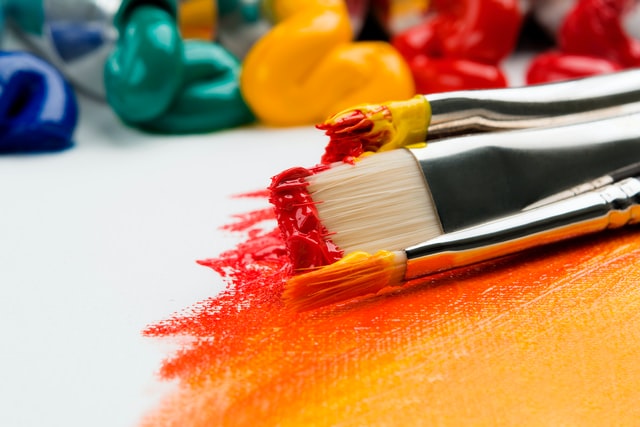
Stay connected.
Sign up to our newsletter for updates on new arrivals and exhibitions


